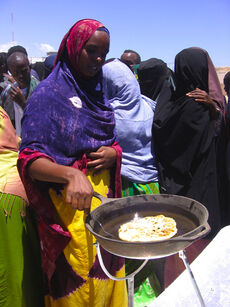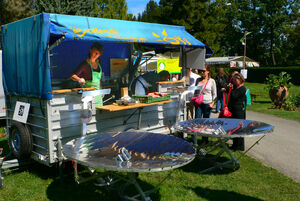
A woman involved with the Sun Fire Cooking project cooks flatbread in a parabolic solar cooker in Somalia.
In our way of thinking, there are three important categories of solar cookers--panel cookers (such as the SCI CooKit), box cookers and concentrating (often parabolic or paraboloid) cookers. Panel cookers are not good for the flat breads I know about. Most box cookers do not get hot enough, although they could be specially designed for the purpose. Parabolic cookers are the most likely candidates as well as cookers like the Devos Solar Cooker.
Another section of the Solar Cooking Archive is called Design and science of solar cookers. In that section, you may be interested in the articles called Making a Parabolic Reflector out of a Flat Sheet and A Parabolic Cooker for Unattended Cooking. If you are interested in the mathematics and theory of parabolic designs, you might like to read the article called Theories Behind a Chinese Reflective Solar Cooker.

Michael Götz has taken his 'Crêperie Solaire' to many music festivals or ecology fairs where visitors get their first culinary experience with solar cooking.
The most common type of parabolic solar cooker in the world is likely to be the "butterfly" type with two not-quite-parabolic reflectors. These are very common in China. For more information, see Yancheng Sangli Solar Energy.
The Ethiopians and Eritreans use a clay griddle for preparing their ingera. This type of griddle is not conductive enough to allow it to be heated hot enough and evenly enough by most solar cookers. We have received two reports of the use of cast iron griddles made in China. These worked much better than the ones made of clay. When ingera is cooked in the traditional way over a wood fire, the correct temperature of the griddle is 180°C.
See also
- Devos Solar Cooker
- Sun Fire Cooking
- Scheffler Community Kitchen
